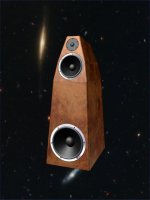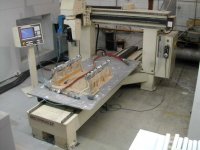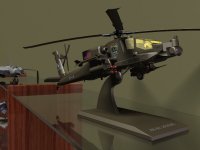Amazing work Shin,
You seem to be having fun and must be putting in some late nights modeling.
Here is a render I just did tonight in Inventor of a concept audio/video 3 way that I want to build. I already have the mid/bass and tweeter. Just need the 12 inch woofer. This is an unusual design using a Vifa 8 inch midbass instead of the usual 6.5 or 7 inch. The speakers are not exact replicas but are more for just visualizing the finished product.
Thanks to Sigurd for letting me barrow a few of his IGES files. It saves me a lot of time!!!
You seem to be having fun and must be putting in some late nights modeling.
Here is a render I just did tonight in Inventor of a concept audio/video 3 way that I want to build. I already have the mid/bass and tweeter. Just need the 12 inch woofer. This is an unusual design using a Vifa 8 inch midbass instead of the usual 6.5 or 7 inch. The speakers are not exact replicas but are more for just visualizing the finished product.
Thanks to Sigurd for letting me barrow a few of his IGES files. It saves me a lot of time!!!
Attachments
Hezz said:Amazing work Shin,
Thanks to Sigurd for letting me barrow a few of his IGES files. It saves me a lot of time!!!
Hezz,
my pleasure
I'll try to add some nice Scanspeak Tweeter models during Easter.
Sigurd
Amps have arrived 
An externally hosted image should be here but it was not working when we last tested it.
They're branded 'class-d' lateral fet's from this company:
http://www.class-d.com/
Edit: Just noticed they're in Mansfield, which is about 20 minutes from me. Small world.
http://www.class-d.com/
Edit: Just noticed they're in Mansfield, which is about 20 minutes from me. Small world.
m0tion said:Too cool. Are you going to put them in the monster ATI chassis? How is that custom preamp from Twisted Pear coming along?
They're going in different cases this time around and I think the pre-amp is dead, I've not heard from Russ for about 6 months. A shame because he'd already done the PCB work. I think the software side of things tripped him up because that's the point where he stopped working on it.
R-Carpenter said:I imagine, you’d need a five axis CNC to cut this multi-angled insanity and 5-axis is yet quite expensive....
HYPERTUNE said:Looks to me like all the parts could be made in a 3 axis machine.
I took the plunge on a hobbyist 3 axis machine at the back end of 2006. One of the first things I found was it's a lot more limited than you'd think.
You're both right in a way - it would be possible to cut the front face of those baffles with a 3 axis machine, but it would take a huge amount of time. A 5 axis machine would be better, but as R-Carpenter noted, they're just a bit pricey. I have looked into them, but some of the small 5 axis heads out there are as heavy as my whole machine
I find the best way to think with the machine is to consider it a 2D 'shape' cutter, with the capability of doing flat bottomed rebates and channels. Trying to do curved/sloping faces is best done using other techniques - like Ant has done by using a mitre saw for his LGT baffles.
ShinOBIWAN said:I realise the GPU does nothing when rendering but you've got to laugh when a GPU can produce 1-2 million frames in the same 8 hours it takes for a single photo realistic render...
It's been a few years since I really got involved in rendering work (my last real coding work was in the late 90s) but there is (or at least was) a huge difference between the way gaming rendering and raytracing works.
The gaming systems used z-buffer technology, with shadows approximated using z-buffer based shadows, and no way to do refraction.
Raytracing is much more complex; tracing the vectors of light through a scene, and taking into account complex diffusion, reflection and refraction.
I last worked on this stuff when diffuse reflection was just being approximated by radiosity (at least in the popular rendering field). I'd guess the methods being used today are way more complex!
As for waiting for long renders... a 486DX2/66 I had in the mid 90s took over a week to render a 640x480 image with loads of glass objects!
ShinOBIWAN said:
Sweet indeed. That open sided render is superb. Nice work!
sploo said:It's been a few years since I really got involved in rendering work (my last real coding work was in the late 90s) but there is (or at least was) a huge difference between the way gaming rendering and raytracing works.
The gaming systems used z-buffer technology, with shadows approximated using z-buffer based shadows, and no way to do refraction.
Raytracing is much more complex; tracing the vectors of light through a scene, and taking into account complex diffusion, reflection and refraction.
I last worked on this stuff when diffuse reflection was just being approximated by radiosity (at least in the popular rendering field). I'd guess the methods being used today are way more complex!
As for waiting for long renders... a 486DX2/66 I had in the mid 90s took over a week to render a 640x480 image with loads of glass objects!
Its come a long way since the late nineties.
Take a look at this comparison:
http://www.gametrailers.com/player/31023.html?type=wmv
Its HD clip of a comparison between the Sony Bravia Ad and a remake using the CryEngine 2 running in real time.
Another one showing some more effects from the same game engine:
http://www.gametrailers.com/player/30967.html?type=wmv
I think 8 hours for a single frame vs. 2 million from the game engine is reasonable compared to that.
I understand that rendering is about the correct approach and exploits the mathematically perfect representation of light, however complex, as completely and as accurately as possible. And realtime 3d is all about tricks and optimisations to achieve decent frame rates and still make it look good.
I just think the gap between photo realistic and realtime 3d has closed to a point where I can say that 8 hours is a slap in the face for not exactly night and day results.
I've seen a few vids of Crysis, and the associated tools, and it does indeed look very impressive.
The Bravia copy is excellent. Not just for the visuals, but the physics engine (which I think is one of the best advancements of modern games).
Ironically, I think they're still mainly using z-buffers (plus some voxel stuff) on Crysis, so some things don't change, but hey, if it works!
Your point about the gap between high speed gaming imagery and renders is well made though. A lengthly render is still better, but the amount of visual affects the modern GPUs can do in realtime is staggering.
I remember using 3D Studio (not Max! DOS based!) in the mid 90s. Its renderer wasn't a raytracer, and if I remember correctly, was basically doing what todays gfx cards are doing in realtime (and not as good either)!
Having said that, as my home PC was last specced to play Half-Life 2, I suspect it'd take 8 hours to produce a frame in Crysis .
.
The Bravia copy is excellent. Not just for the visuals, but the physics engine (which I think is one of the best advancements of modern games).
Ironically, I think they're still mainly using z-buffers (plus some voxel stuff) on Crysis, so some things don't change, but hey, if it works!
Your point about the gap between high speed gaming imagery and renders is well made though. A lengthly render is still better, but the amount of visual affects the modern GPUs can do in realtime is staggering.
I remember using 3D Studio (not Max! DOS based!) in the mid 90s. Its renderer wasn't a raytracer, and if I remember correctly, was basically doing what todays gfx cards are doing in realtime (and not as good either)!
Having said that, as my home PC was last specced to play Half-Life 2, I suspect it'd take 8 hours to produce a frame in Crysis
Regarding the 3 and 5 axis machining I have a couple of comments. And I know a little about cam applications and have worked in a machine shop.
OK, the 3 axis method would be easier to program in software but would take a longer machining time and leave little scallops on the surface which would need to be worked out by hand unless you took a long time to machine it. The cost of having it done would be more than the entire speaker project so unless you have a buddy that has access to these machines that he can use the hand method is the best bet.
A 5 axis machine is a lot harder to program and some can be programmed at the machine like Mazak's. But only someone very good could do it fast. As in a few hours.
Interpolating in multiple planes simultaneously cannot usually be programmed at the machine and reguires cam software like MasterCam to do. It would take someone really good with the software an hour or two to set up. Wood can be cut at high feed rates compared to metal so the time would not be that bad for 3 axis. Still the cost would be high to pay to have it done. I estimate at least 3000-5000 USD to have it done.
OK, the 3 axis method would be easier to program in software but would take a longer machining time and leave little scallops on the surface which would need to be worked out by hand unless you took a long time to machine it. The cost of having it done would be more than the entire speaker project so unless you have a buddy that has access to these machines that he can use the hand method is the best bet.
A 5 axis machine is a lot harder to program and some can be programmed at the machine like Mazak's. But only someone very good could do it fast. As in a few hours.
Interpolating in multiple planes simultaneously cannot usually be programmed at the machine and reguires cam software like MasterCam to do. It would take someone really good with the software an hour or two to set up. Wood can be cut at high feed rates compared to metal so the time would not be that bad for 3 axis. Still the cost would be high to pay to have it done. I estimate at least 3000-5000 USD to have it done.
http://toolmonger.com/2007/07/31/tool-pr0n-matsuura-5-axis-mill/
..it has a certain mezmerising quality.
..it has a certain mezmerising quality.
The above movie shows how cool those five axis machines are. And there are others ones even cooler than that one. However, just to bring everyone down to reality, there needs to be some input here. That process is not cost effective for anything except one-off prototypes on which tens of thousands of dollars are spent. Even the big car manufacturers do not use those methods for making engine blocks for several reasons.
Programming that engine block would take a week or weeks depending on the skill and experience of the programmer. This would drive the cost very high not to mention the fact that most machine shops would not even consider doing wood on a machine that was not dedicated to that purpose because it will damage the machine. The sawdust gets into the coolant areas and creates a mush that will require the whole machine to be cleaned out.
It doesn't even make sense to approach a DIY speaker project in this way as you could build up a fiberglass/carbon fiber/epoxy cabinet by hand for less money than it would take to get the MDF machined. And you would have a far superior speaker cabinet.
However, if you were to do it CNC this is the kind of machine you would want since the machine capacity needs to be designed for the size of components that you are working on.
Here is a 5 axis router with a 4 x 8 foot bed. This used machine is selling for 50,000 USD.
Programming that engine block would take a week or weeks depending on the skill and experience of the programmer. This would drive the cost very high not to mention the fact that most machine shops would not even consider doing wood on a machine that was not dedicated to that purpose because it will damage the machine. The sawdust gets into the coolant areas and creates a mush that will require the whole machine to be cleaned out.
It doesn't even make sense to approach a DIY speaker project in this way as you could build up a fiberglass/carbon fiber/epoxy cabinet by hand for less money than it would take to get the MDF machined. And you would have a far superior speaker cabinet.
However, if you were to do it CNC this is the kind of machine you would want since the machine capacity needs to be designed for the size of components that you are working on.
Here is a 5 axis router with a 4 x 8 foot bed. This used machine is selling for 50,000 USD.
Attachments
Hi Hezz,
Yea, as you point out - it can be done with a 3 axis machine, but it's a compromise between speed and quality (or rather, how much time the machine spends cutting vs how much time you spend cleaning the part up).
I've never actually cut any textured stuff (carving, sloping faces etc.) with my machine, as it takes ages, usually creates even more dust than 2d jobs, and I try to keep the machine's running time down as I couldn't afford to replace it if it broke!
Yea, as you point out - it can be done with a 3 axis machine, but it's a compromise between speed and quality (or rather, how much time the machine spends cutting vs how much time you spend cleaning the part up).
I've never actually cut any textured stuff (carving, sloping faces etc.) with my machine, as it takes ages, usually creates even more dust than 2d jobs, and I try to keep the machine's running time down as I couldn't afford to replace it if it broke!
DaveM said:Check out this rendering. Thought you would like it. This is a solidworks photoworks render.
Excellent work Dave.
I notice the F16 Falcon in that shot. I'm more of jet fighter guy than an attack chopper guy. Any chance you could do another render of the F16?
What's the jet above BTW? Tornado, F22 or something?
- Status
- This old topic is closed. If you want to reopen this topic, contact a moderator using the "Report Post" button.
- Home
- Loudspeakers
- Multi-Way
- 'LGT' Construction Diary



 .
. .
.